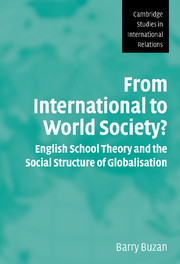 From International to World Society?
From International to World Society? Published online by Cambridge University Press: 14 January 2010
This book started conscious life when I decided in the late 1990s to attempt a reconvening of the English school. Much of its agenda is already visible in a paper I wrote for the public launch of that project at the BISA Conference in 1999, and subsequently published in the Review of International Studies as part of a forum on the English school. That paper opens many of the criticisms of the English school classics, and some of the suggestions as to how to develop and apply the theory, that are followed up here. This book has deeper roots both in my earlier attempts to link English school ideas to American IR theory, which I extend here, and in my world historical writings with Richard Little, which point strongly towards the English school as an excellent site for developing grand theory. Its particular genesis was a growing feeling that a lot of the problems I saw in English school theory hinged on the concept of world society. World society occupied a key place in a triad alongside international society and international system, but was the Cinderella of English school theory, attracting neither consistent usage nor, and in contrast to international society, any systematic attempt to explore its meaning. The vagueness attending world society seemed to underpin a lot of the problems in English school theory about pluralism and solidarism, and how to handle the cosmopolitan and transnational aspects of international life.
To save this book to your Kindle, first ensure [email protected] is added to your Approved Personal Document E-mail List under your Personal Document Settings on the Manage Your Content and Devices page of your Amazon account. Then enter the ‘name’ part of your Kindle email address below. Find out more about saving to your Kindle.
Note you can select to save to either the @free.kindle.com or @kindle.com variations. ‘@free.kindle.com’ emails are free but can only be saved to your device when it is connected to wi-fi. ‘@kindle.com’ emails can be delivered even when you are not connected to wi-fi, but note that service fees apply.
Find out more about the Kindle Personal Document Service.
To save content items to your account, please confirm that you agree to abide by our usage policies. If this is the first time you use this feature, you will be asked to authorise Cambridge Core to connect with your account. Find out more about saving content to Dropbox.
To save content items to your account, please confirm that you agree to abide by our usage policies. If this is the first time you use this feature, you will be asked to authorise Cambridge Core to connect with your account. Find out more about saving content to Google Drive.